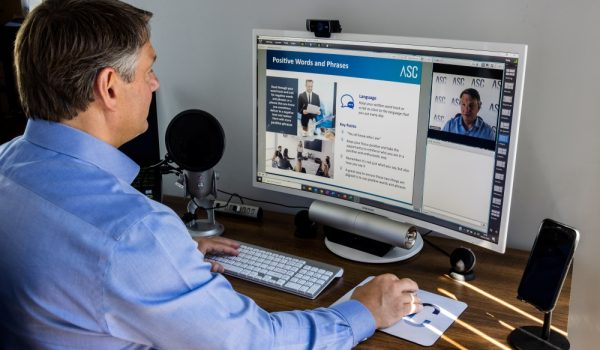Virtual Learning –
So, something changed recently. After just over 10 years of working hard to introduce virtual learning as part of a blended solution and having some success, we find that the whole world has been thrown into the virtual arena. For me this is orbiting to be a very interesting time.
Trying to introduce Virtual Classroom Training in 2009/ 2010 was very challenging for a number of reasons. Firstly, people were not equipped to join virtual sessions. On several programmes we had to literally go out and visit our participants first to set them up, provide a headset and talk them through the logging in process. Secondly, they were not prepared for virtual learning. Sitting at a desk in the middle of a showroom or being constantly interrupted by other members of staff that simply did not realise they were part of an online training session. And lastly, we were not prepared.
The First Lesson
Having been introduced to Adobe Connect as a virtual classroom tool we were tasked to create and deliver a virtual element of a blended solution for a major client. No problem, how hard can it be?
Our first mistake was thinking that it would work in the same way as a face-to-face training session, but there are a number of considerations we hadn’t considered above and beyond the obvious.
The clear differences were evident, shorter time period, lack of conversation and participation would impact on certain learning mechanisms such as led/ self-discovery and collaborative exercises. What we hadn’t considered was the lack of feedback, any technical issues, an unfamiliar process and how these would have an impact on us as trainers.
Working as a pair to manage the first few sessions, what we found out straight away was that rehearsal is absolutely key. This was like going live on TV and without the right amount of rehearsal then we were open to obvious errors, awkward moments and mistakes. The funny thing is, most participants probably don’t even notice the awkward moments or minor mistakes, but because we were out of our comfort zone we certainly did and that then affected our delivery massively.
The second thing we identified is that virtual delivery is not face-to-face delivery. This may seem obvious but what I mean is that in order for it to be an engaging session at the right pace, then you need to write it differently from a classroom session.
Why? Well mostly because you lose that ability to manage the room. This is where I need to differentiate the different styles of virtual delivery.
1/ Meetings: Virtual meetings can be easy to manage and simply require a host, a structure, supporting materials and a platform. We currently use Zoom or Teams for meetings as they focus on the evident interaction and provide a more stable tool for simple face-to-face meetings. We still prepare supporting materials, PowerPoint and handouts or downloads to support the outcomes but pretty simple in their design.
2/ One-to-One and Small Group Sessions: In relation to actual training and learning we use Adobe Connect as it provides more interactive tools to engage with learners, create learning activities and lead to/ reinforce key learning points. Polls, quizzes, exchange and download of documents, video and audio interaction, as well as presentation and video sharing. For small groups we use full video and audio interaction but pace the sessions to allow for response times and technical issues.
3/ Broadcast Sessions: When we are delivering to a larger audience than 3 or 4 participants we switch to a broadcast. By this I mean the trainer/ presenter will display video and communicate via audio, but the participants will communicate through the chat box. This reduces any chance of technical issues, especially over-talking and audio background noise/ disruptions and interruptions. For this style we need to develop the materials to a much greater degree and provide further support throughout.
Time to Research
Following a few of our first sessions I decided to research and see what information I could find about not just virtual learning but distance and digital learning as a whole and I found there to be very little information available.
What I did find was an article published by the University of Middlesex following a study of people engaged in e-learning and digital/ distance learning. What I discovered in this document went on to be the core foundation of our current approach to developing suitable, effective courses that can be delivered virtually.
The paper outlined four key areas in this type of learning. The first area concerned dialogue. In a training room the trainer can engage dialogue around any particular subject through conversation, easy enough to do. Participants respond and questions are raised, the conversation should follow the line of questioning and before you know it not only have you uncovered the learning point, but you have also probably worked through the first 3 stages of `Kolb’s learning style theory’ (Concrete Example, Reflective Observation and Abstract Conceptualisation). This leads to self-discovery which can then be reinforced and create a mindset change in line with the Cognitive Dissonance/ Affective domain issues that we often face. Now, considering virtual learning, without two-way dialogue how do we create that same dialogue? Here’s where things start to get fun.
The first thing we need to do though is change our mindset. I have recently had several conversations with very successful coaches and trainers who, faced with the thought of switching to virtual platforms, were worried about how they can achieve this without managing a group discussion or led-discovery session. The answer is actually quite simple. Instead of focussing on the external dialogue, simply focus on the internal dialogue. Create a dialogue path that leads to the desired conclusion and relates to the learner’s values/ beliefs or situation. Now that you have the starting point, pathway and desired outcomes, it’s ideal to provide the materials that lead to that outcome in isolation. For example, in a classroom training scenario a trainer can pose a questions, flipchart the responses, explore the desired ones, ‘park’ the not-so-desirable ones and lead to the outcomes. In a virtual classroom setting we need to pose more questions that provide smaller responses and provide a structured document or exercise that achieves the overall outcome in small stages.
How do you make a cup of tea? This question can lead to a whole world of debate and would be a fun subject in a classroom scenario to explore processes, process management, controls and measures, etc. In a virtual environment you could break this down to smaller questions:
- What’s your preferred way to boil water? (This might lead to ‘kettle’ as an answer)
- Do you keep your kettle full or just use the amount of water you need for the tea you’re going to make? (this might lead to consideration for the power usage to boil the amount of water you need)
- What size and shape of cup do you prefer?
- Which goes first water or milk?
- How long do you brew for?
- What’s the best colour for your tastes?
Now I can start to consider how I encourage the learners to participate in the responses to control the outcomes. I can use:
- A chat box for open responses
- Multiple choice for selective/ led responses
- Multiple answer for considered and reflective responses
- Q&A for verification
- Presentation slides to reinforce the key learning points.
So, what we found was that you can achieve the same learning outcomes, but you must change the way you think about virtual learning and invest more time in creating effective materials to support the dialogue.
The second factor was access. We need to make the online training sessions easy to access and the information from the session easy to find. If a learner attends a classroom session the likelihood is that they will take-away a workbook, handouts, information sheets and notes. This doesn’t always happen on virtual courses, therefore even just a short time after the session the learning is lost. The Ebbinghaus curve will tell us that we need to provide sustainment activities and supporting materials to refocus the learning points and allow for further investigation after the session. Therefore, well prepared material that reinforce the learning after the session can have a huge impact on the overall learning outcomes themselves. Using work-based tasks and activities post-session can also have a major impact on the Kirkpatrick levels 4 and 5. Without downloadable materials this is much reduced.
The third factor is support, again this includes directions to access information discussed in the session and further study areas. Recording the session and making them available, supporting podcasts and articles will also have a huge impact on the learners’ overall experience.
The last factor is an interesting one, control. This relates to the fact that some learners are more resistant than others and to ensure the majority of learners’ progress to the desired level as determined by the defined learning outcomes, then there need to be controls in place. These controls will include timescales, tasks to be completed, knowledge improvements and work-based tasks applied. These can be achieved through:
- Knowledge testing – polls, quizzes and feedback
- Completion of tasks to progress to the next learning piece/ module, etc
- Testing/ examinations to verify overall learning.
In a recent discussion with a trusted and almost revered colleague who is personally going through this transition process, I surmised the differences between physical training and virtual training as like being asked to play football in a swimming pool. You simply cannot run in a swimming pool or effectively kick the ball. However, what you can do, with a different mindset is have an engaging and entertaining competitive match with a ball and nets, two teams, points and passing/ scoring. It’s a different game (water polo) but it’s no less enjoyable and effective as the original game, it’s just in a different environment.
Welcome to the world of Virtual.
Thank you for reading
– Alan
Share:

